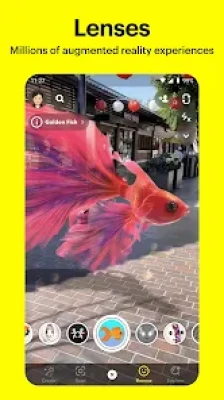
Latest Version
One of the latest Android versions: 13.11.0.42 And Also versions like 13.55.0.49 are available in some listings.
September 16, 2025
Snap Inc.
Approx ~156.4 MB for version 13.11.0.42 on Android.
90,004
Proprietary / Free to download, with optional in‑app purchases or premium features. Terms of Service & Privacy Policy apply. (Not open source.)
com.snapchat.android AndroidAPKsFree +3
Report a Problem
More About Snapchat
Snapchat is a widely‑used multimedia messaging platform that has shaped how people share visual content, communicate, and interact online. At its core, Snapchat allows users to send “Snaps”—photos or videos that are typically ephemeral; once viewed by the recipient, these vanish (unless saved or screenshotted). The platform extends beyond ephemeral messaging: users post to their Story where friends can view content for 24 hours; they engage through text, voice, or video chat; and they make video calls. One of Snapchat’s signature features is its camera with AR lenses, face filters, Bitmoji avatars, and creative tools that allow users to transform, overlay, or animate their images and videos in fun, artistic ways.
Discovery is also central to Snapchat’s appeal. The Spotlight feature shows user‑generated public content in a curated feed similar to short video platforms. The Discover section provides curated content from media partners. Snap Map enables sharing location with friends and seeing what’s happening around the world. In addition, Snapchat supports ephemeral content, with privacy built in: many communications are not stored permanently, and options exist for messages to disappear. For those concerned about safety, Snapchat offers privacy settings, control over who can view your content, and reporting tools.
Snapchat continues to evolve with new versions regularly releasing more filters, improved AR experiences, better media sharing, richer interactive features (games, augmented reality), and improvements to chat, video, and group communication. It supports cross‑platform use for mobile devices, and continually optimizes its app for newer hardware, better cameras, faster internet, etc. Users appreciate Snapchat for its immediacy, creative freedom, fun with filters and lenses, and the way it makes communication visually expressive and temporally lively. Its large user base, social features, and constant innovation make it a mainstay in social media, particularly among younger users.
Rate the App
User Reviews
Popular Apps










Editor's Choice















